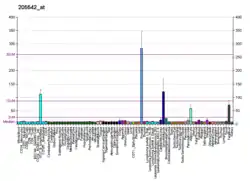STEAP1
Metalloreductase STEAP1 is an enzyme that in humans is encoded by the STEAP1 gene.[5]
This gene is predominantly expressed in prostate tissue, and is found to be upregulated in multiple cancer cell lines. The gene product is predicted to be a six-transmembrane protein, and was shown to be a cell surface antigen significantly expressed at cell-cell junctions.[5]
References
- GRCh38: Ensembl release 89: ENSG00000164647 - Ensembl, May 2017
- GRCm38: Ensembl release 89: ENSMUSG00000015652 - Ensembl, May 2017
- "Human PubMed Reference:". National Center for Biotechnology Information, U.S. National Library of Medicine.
- "Mouse PubMed Reference:". National Center for Biotechnology Information, U.S. National Library of Medicine.
- "Entrez Gene: STEAP1 six transmembrane epithelial antigen of the prostate 1".
Further reading
- Sanger Centre, The; Washington University Genome Sequencing Cente, The (1999). "Toward a complete human genome sequence". Genome Res. 8 (11): 1097–108. doi:10.1101/gr.8.11.1097. PMID 9847074.
- Hubert RS, Vivanco I, Chen E, et al. (2000). "STEAP: A prostate-specific cell-surface antigen highly expressed in human prostate tumors". Proc. Natl. Acad. Sci. U.S.A. 96 (25): 14523–8. doi:10.1073/pnas.96.25.14523. PMC 24469. PMID 10588738.
- Yang D, Holt GE, Velders MP, et al. (2001). "Murine six-transmembrane epithelial antigen of the prostate, prostate stem cell antigen, and prostate-specific membrane antigen: prostate-specific cell-surface antigens highly expressed in prostate cancer of transgenic adenocarcinoma mouse prostate mice". Cancer Res. 61 (15): 5857–60. PMID 11479226.
- Korkmaz KS, Elbi C, Korkmaz CG, et al. (2002). "Molecular cloning and characterization of STAMP1, a highly prostate-specific six transmembrane protein that is overexpressed in prostate cancer". J. Biol. Chem. 277 (39): 36689–96. doi:10.1074/jbc.M202414200. PMID 12095985.
- Strausberg RL, Feingold EA, Grouse LH, et al. (2003). "Generation and initial analysis of more than 15,000 full-length human and mouse cDNA sequences". Proc. Natl. Acad. Sci. U.S.A. 99 (26): 16899–903. doi:10.1073/pnas.242603899. PMC 139241. PMID 12477932.
- Scherer SW, Cheung J, MacDonald JR, et al. (2003). "Human Chromosome 7: DNA Sequence and Biology". Science. 300 (5620): 767–72. doi:10.1126/science.1083423. PMC 2882961. PMID 12690205.
- Hillier LW, Fulton RS, Fulton LA, et al. (2003). "The DNA sequence of human chromosome 7". Nature. 424 (6945): 157–64. doi:10.1038/nature01782. PMID 12853948.
- Gerhard DS, Wagner L, Feingold EA, et al. (2004). "The Status, Quality, and Expansion of the NIH Full-Length cDNA Project: The Mammalian Gene Collection (MGC)". Genome Res. 14 (10B): 2121–7. doi:10.1101/gr.2596504. PMC 528928. PMID 15489334.
- Rodeberg DA, Nuss RA, Elsawa SF, Celis E (2005). "Recognition of Six-Transmembrane Epithelial Antigen of the Prostate–Expressing Tumor Cells by Peptide Antigen–Induced Cytotoxic T Lymphocytes". Clin. Cancer Res. 11 (12): 4545–52. doi:10.1158/1078-0432.CCR-04-2235. PMC 1698136. PMID 15958640.
This article is issued from Wikipedia. The text is licensed under Creative Commons - Attribution - Sharealike. Additional terms may apply for the media files.




